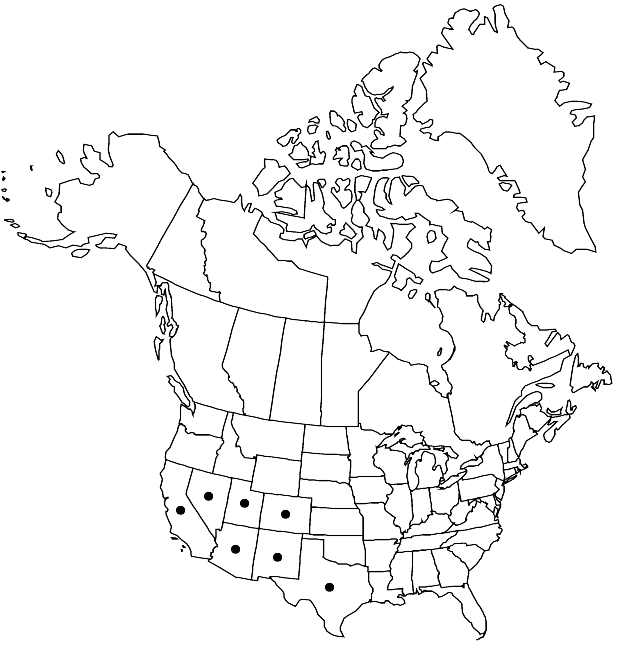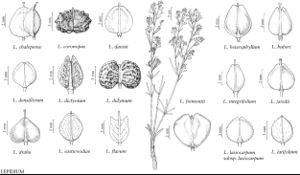Lepidium lasiocarpum
in J. Torrey and A. Gray, Fl. N. Amer. 1: 115. 1838.
Annuals; hirsute or hispid, (trichomes cylindrical). Stems usually few to several, rarely simple from base, erect to ascending or (outer ones) decumbent, branched distally, (0.15–) 0.6–3 (–3.8) dm. Basal leaves (later withered); not rosulate; petiole (0.4–) 1–3.5 (–5) cm; blade spatulate to oblanceolate, lyrate-pinnatifid, pinnatisect, or 2-pinnatifid, (0.7–) 1.5–4.5 (–7.5) cm × (9–) 12–20 (–30) mm, margins rarely dentate, (lobes) entire or dentate. Cauline leaves subsessile or petioles 0.8–2.2 cm, blade lanceolate to oblanceolate, (0.7–) 1.2–3.3 (–5) cm × (2–) 4–12 mm, base cuneate, not auriculate, margins subentire to dentate. Racemes often considerably elongated in fruit; rachis hirsute or hispid, trichomes straight, cylindrical. Fruiting pedicels divaricate-ascending to horizontal, straight or slightly curved, (often strongly flattened), (1.8–) 2–4 (–4.6) × 0.2–0.7 mm (to 0.3 mm thick), hirsute to hispid throughout or adaxially. Flowers: sepals oblong, 1–1.3 (–1.5) × 0.5–0.8mm; petals (sometimes absent), white, oblanceolate to linear, (0.3–) 0.6–1.5 (–2) × (0.1–) 0.2–0.5 mm, claw absent; stamens 2, median; filaments 1–1.4 mm; anthers 0.2–0.3 mm. Fruits ovate to ovate-orbicular, 2.8–4 (–4.6) × 2.4–3.6 (–4) mm, (base broadly cuneate to rounded), apically winged, apical notch (0.2–) 0.3–0.6 (–0.7) mm deep; valves thin, smooth, not veined, hirsute to hispid (on surface or margin); style obsolete or to 0.1 mm, included in apical notch. Seeds ovate, 1.4–2.2 × 0.9–1.4 mm.
Distribution

Ariz., Calif., Colo., N.Mex., Nev., Tex., Utah, n Mexico
Discussion
Subspecies 3 (2 in the flora).
R. C. Rollins (1993) and C. L. Hitchcock (1945) divided Lepidium lasiocarpum into four and seven varieties, respectively. Hitchcock admitted that the species is highly variable in every aspect and that his varieties cover some of the “more conspicuous” variations. In our opinion, perhaps two or three groups are somewhat sufficiently defined to be recognized formally, though the lines separating them blur in some parts of the species range. We are reluctantly treating them as subspecies; subsp. palmeri (S. Watson) Thellung is restricted to Mexico (Baja California). The other infraspecific taxa recognized by those authors are based on trivial differences in leaf and indumentum, and we do not believe that they merit recognition.
The reports by R. C. Rollins (1993) and N. H. Holmgren (2005b) of four and six stamens in Lepidium lasiocarpum were most likely repeated from C. L. Hitchcock (1936, 1945b) without further verification. We have examined hundreds of specimens that definitely belong to this species, and in not a single case did we find a flower with more than two stamens. It is quite likely that the reports of more than two stamens were based on misidentified plants.
Selected References
None.
Key
| 1 | Fruit valves hirsute (or fringed on margin), trichomes not pustular-based; fruiting pedicels 0.2-0.4(-0.6) mm wide, usually less than 3 times as wide as thick; nectar glands toothlike, to 0.2 mm. | Lepidium lasiocarpum subsp. lasiocarpum |
| 1 | Fruit valves hispid, trichomes pustular-based; fruiting pedicels (0.4-)0.5-0.7 mm wide, often more than 3 times as wide as thick; nectar glands not toothlike (subulate), 0.3-0.5 mm. | Lepidium lasiocarpum subsp. wrightii |
"elongated" is not a number."thick" is not a number."dm" is not declared as a valid unit of measurement for this property."dm" is not declared as a valid unit of measurement for this property.
